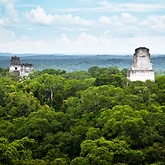Coopertiva Carmelita is a community forest concession located in the Petén region of northern Guatemala. Community inhabitants engage in the extraction of sustainable timber and non-timber products while acting as the custodians of this biodiverse and historically rich landscape.
Managing forests sustainably
Coopertiva Carmelita has been operating since 1998 to sustainably manage a 55,000 ha area in the Mayan Biosphere Reserve. The once former rubber encampment is now officially designated as a protected area by the Guatemalan State, and its community of 411 inhabitant operate in accordance to a strict forest management plan that is reported to the National Council of Protected Areas (CONAP).
The concession’s plan adopts a minimal intervention model, meaning that during a 40 year harvesting cycle only 2 to 4 cubic meters of wood is extracted per hectare. The sustainable operations in the forest help to conserve it from illegal poaching, smuggling, and mining, and also provide the community with a major source of employment. Carmelita also benefits from its mill, which benefits the residents as they are empowered to directly offer round and sawn wood of high value species to local and international markets.
Along with income generated from the sale of timber, Carmelita’s harvest cycle receives a working capital credit line from the Forest and Climate Change Fund (FCCF), which is processed with the support of Rainforest Alliance and ACOFOP. This financing necessitates that the community hits the FCCF’s environmental impact objectives, which includes promoting a wider range of secondary and lesser-known timber species to ensure a sustainable forest management over the long term.
Coopertiva Carmelita Concession Boundary


Carmelita community members showing off food they foraged in their concession
Supporting local economic development
Even though forestry provides a great deal of employment to the community, its members have also created a number of other revenue streams to support Carmelita’s growth. Due to the community's close proximity to the biological corridor of El Mirador National Park, it is able to engage in ecotourism that employs most of Carmelita’s inhabitants. Agroforestry activities that involve the extraction and processing of honey, xate palm, chicle, and allspice, also provides income which is then distributed amongst the community.
Carmelita's profit sharing model redistributes funds by allocating 10% for activities that strengthen the community, 10% for social projects, 10% for educational projects, and the remaining 70% is distributed as salaries.
Coopertiva Carmelita, Guatemala
This map of the Carmelita Concession shows it in its broader geographic context. Click here to learn more.
Did you know?
-
The Mayan Biosphere Reserve in the Petén region of northern Guatemala, together with the Maya Forest of Belize and Mexico represents one of the largest areas of tropical forest north of the Amazon and the northernmost tropical forest in the Western Hemisphere.
-
According to the U.N. FAO, 33.7% or about 3,657,000 ha of Guatemala is forested, 44.3% ( 1,619,000 ) being classified as primary forest, the most biodiverse and carbon-dense form of forest.
-
The Mayan Biosphere Reserve contains more than two dozen different management units, 10 of which are community forest concessions.
Learn more about Guatemalan forestry
Learn more about Coopertiva Carmelita by watching this
Read this Rainforest Alliance article and watch their video to learn more about the different communities living in the Mayan Biosphere Reserve.
Learn more about the history of Guatemala's forestry by reading this CIFOR document.



